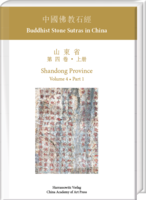|
|
more titles of the subject:
Download:
This two volume work deals with the greatest of all the stone inscriptions in China: the Diamond Sutra, carved at the end of the sixth century, on a slope of roughly 2000 square meters, in the lush landscape of Sutra Stone Valley on Mount Tai. The introduction to Part 1 The Sutra consists of four articles: “A Panoramic View” by Lothar Ledderose, “The Diamond Sutra on Mount Tai” by Claudia Wenzel, which embeds the sutra in the local history of Buddhism, “The Sutra as Stupa” by Tsai Suey-Ling, which investigates how the site originally functioned in religious practice, and “The Historiography of Sutra Stone Valley” by Manuel Sassmann, who traces scholarly engagement with the site from the tenth century till the present day. That section also contains extensive information about the site, the sutra and its reproductions, as well as photographs and rubbings of the characters on the rock, an orthophotographically rectified image of the entire stone surface, and the reconstructed layout of the text.
Part 2 presents the 62 colophons, which were added to the site. It starts with an article on “A Lost Inscription at Sutra Stone Valley” by Zhou Ying, who analyses evidence for a lost sixteenth-century engraving of the Confucian classic the Great Learning. “The Colophons of Sutra Stone Valley” by Lothar Ledderose and Tsai Suey-Ling, present an overview of the colophons at the site through the centuries. In the subsequent catalog, all the colophons are documented in detail, transcribed and translated, and each is accompanied by photographs, both historical and contemporary. Biographical information on the makers of the inscriptions and interpretations of their texts allow to understand how attitudes towards the Diamond Sutra developed and changed over the course of time. The reader is also taken on a tour of other inscriptions on the mountain by the colophon writers, and thus gains a multifaceted, holistic view of one of China’s greatest monuments. |






